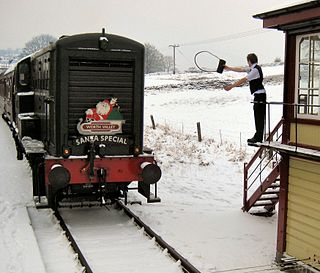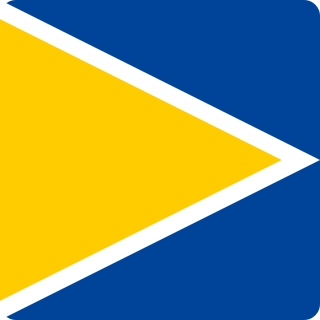Related Research Articles

Railway signalling is a system used to direct railway traffic and keep trains clear of each other at all times. Trains move on fixed rails, making them uniquely susceptible to collision. This susceptibility is exacerbated by the enormous weight and momentum of a train, which makes it difficult to quickly stop when encountering an obstacle. In the UK, the Regulation of Railways Act 1889 introduced a series of requirements on matters such as the implementation of interlocked block signalling and other safety measures as a direct result of the Armagh rail disaster in that year.

In railway signalling, a token is a physical object which a train driver is required to have or see before entering onto a particular section of single track. The token is clearly endorsed with the names of the section it belongs to. A token system is more commonly used for single lines because of the greater risk of collision in the event of a mistake being made by a signaller or traincrew, than on double lines.
A track warrant is a set of instructions issued to a train crew authorizing specific train movements. The system is widely used in North America. The warrant is issued by the train dispatcher and delivered to the train crew via radio. The train crew copies the instructions onto a pre-printed paper form and reads back the warrant to ensure that nothing was misunderstood.

The AB Standard was a New York City Subway car class built by the American Car and Foundry Company and Pressed Steel Car Company between 1914 and 1924. It ran under the operation of the Brooklyn Rapid Transit Company (BRT) and its successors, which included the Brooklyn–Manhattan Transit Corporation (BMT), the New York City Board of Transportation, and the New York City Transit Authority (NYCTA). The cars were designed following the signing of the Dual Contracts, which called for a major expansion of the BRT. A total of 950 cars were built.

A track circuit is a simple electrical device used to detect the presence or absence of a train on rail tracks, used to inform signallers and control relevant signals.

The railway signalling system used across the majority of the United Kingdom rail network uses lineside signals to control the movement and speed of trains.

Transmission Voie-Machine is a form of in-cab signalling originally deployed in France and is mainly used on high-speed railway lines. TVM-300 was the first version, followed by TVM-430.
Standards for North American railway signaling in the United States are issued by the Association of American Railroads (AAR), which is a trade association of the railroads of Canada, the US, and Mexico. Their system is loosely based on practices developed in the United Kingdom during the early years of railway development. However, North American practice diverged from that of the United Kingdom due to different operating conditions and economic factors between the two regions. In Canada, the Canadian Rail Operating Rules (CROR) are approved by the Minister of Transport under the authority of the Railway Safety Act. Each railway company or transit authority in Canada issues its own CROR rulebook with special instructions peculiar to each individual property. Among the distinctions are:

An Axle Counter is a system used in the railway to detect the clear or occupied status of a section between two points. The system generally consists of a wheel sensor and an evaluation unit for counting the axles of the train both into and out of the section. They often are used in place of a Track Circuit.
The Toronto subway uses a variety of signalling systems on its lines, consisting of a combination of fixed block signalling and moving block signalling technologies.

Signaling and operation on the Washington Metro system involves train control, station identification, train signaling, signage, and train length. As with any working railroad, communication between train operators, dispatchers, station personnel and passengers is critical. Failures will result in delays, accidents, and even fatalities. It is therefore important that a comprehensive signal system operated by a central authority be in place. This gives individual train and station operators the information they need to safely and efficiently perform their tasks.

Signalling block systems enable the safe and efficient operation of railways by preventing collisions between trains. The basic principle is that a route is broken up into a series of sections or "blocks". Only one train may occupy a block at a time, and the blocks are sized to allow a train to stop within them. That ensures that a train always has time to stop before getting dangerously close to another train on the same line. The block system is referred to in the UK as the method of working, in the US as the method of operation, and in Australia as safeworking.

A train dispatcher (US), rail traffic controller (Canada), train controller (Australia), train service controller (Singapore) or signalman (UK), is employed by a railroad to direct and facilitate the movement of trains over an assigned territory, which is usually part, or all, of a railroad operating division. The dispatcher is also responsible for cost effective movement of trains and other on-track railroad equipment to optimize physical (trains) and human resource (crews) assets.
Direct traffic control (DTC) is a system for authorizing track occupancy used on some railroads instead of or in addition to signals. It is known as "direct" traffic control because the train dispatcher gives track authority directly to the train crew via radio, as opposed to through wayside personnel via telephone or telegraph, as in train orders.

A crew car is a passenger carriage specially fitted out for the use of train drivers. Interior fittings include a sleeping compartment for each crew member, a lounge area, kitchen, bathroom, and laundry. They are usually provided with an onboard generator system and air conditioning.
The General Code of Operating Rules (GCOR) is a set of operating rules for railroads in the United States. The GCOR is used by Class I railroads west of Chicago, most of the Class II railroads, and many Short-line railroads.

Automatic block signaling (ABS) is a railroad communications system that consists of a series of signals that divide a railway line into a series of sections, or "blocks". The system controls the movement of trains between the blocks using automatic signals. ABS operation is designed to allow trains operating in the same direction to follow each other in a safe manner without risk of rear-end collision. The introduction of ABS reduced railways' costs and increased their capacity. Older manual block systems required human operators. The automatic operation comes from the system's ability to detect whether blocks are occupied or otherwise obstructed, and to convey that information to approaching trains. The system operates without any outside intervention, unlike more modern traffic control systems that require external control to establish a flow of traffic.

North American railroad signals generally fall into the category of multi-headed electrically lit units displaying speed-based or weak route signaling. Signals may be of the searchlight, color light, position light, or color position light types, each displaying a variety of aspects which inform the locomotive engineer of track conditions so that he or she may keep their train under control and able to stop short of any obstruction or dangerous condition.

Pulse code cab signaling is a form of cab signaling technology developed in the United States by the Union Switch and Signal corporation for the Pennsylvania Railroad in the 1920s. The 4-aspect system widely adopted by the PRR and its successor railroads has become the dominant railroad cab signaling system in North America with versions of the technology also being adopted in Europe and rapid transit systems. In its home territory on former PRR successor Conrail owned lines and on railroads operating under the NORAC Rulebook it is known simply as Cab Signaling System or CSS.

The Harvey train collision took place on 12 October 1979, when the Shawnee train operated by Amtrak between Carbondale and Chicago Union Station crashed into a parked Illinois Central Gulf freight train, leading to the death of two crew members.
References
- ↑ "6.0 Movement of Trains and Engines". General Code of Operating Rules. Retrieved October 19, 2010.
| This United States rail–related article is a stub. You can help Wikipedia by expanding it. |